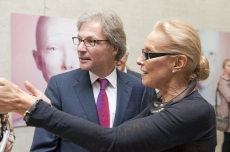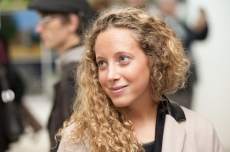I am who I am















Igor Moukhin. Moscow (Graduates), 1999. Digital print. Collection of Multimedia Art Museum, Moscow
Alexander Brodsky. Barrel organ, 2006. Mixed technique. Courtesy of the Artist, ART4.Ru Museum
Ivan Mikhailov. From the ‘Playground’ series, 2010. Digital print. Collection of Multimedia Art Museum, Moscow
Aslan Gaysumov. Untitled. From the series ‘Untitled (War)’, 2011. Artist’s collection
Ilya Batrakov. From the ‘Without face’ series, 2012. Digital print. Artist’s collection
Anna Skladmann. Lisa Sitting on Her Dining Table. Moscow, 2010 From the ‘Little Adults’ series. Digital print. Collection of Multimedia Art Museum, Moscow
Mikhail Maximov. Barriers. Part I, 2011. Video, wood, metal. Collection of Multimedia Art Museum, Moscow
АВС group (Art Business Consulting). Satellite. 2009. Mixed technique. Collection of Multimedia Art Museum, Moscow
Taus Makhacheva. Untitled 2. Dagestan, 2011. From the series ‘The Fast and The Furious’. Digital print. Courtesy of the Artist, Paperworks Gallery, Moscow and Laura Bulian Gallery, Milan
Sayana Mongush. Orlan Bayan (32), disabled, blind from birth, shaman since 1995. From the ‘Shaman-office’ series. Tuva, 2010–2011. Digital print. Collection of Multimedia Art Museum, Moscow
Sergey Shestakov. From the series ‘Journey into the Future. Stop #1’. 2010. Digital print. Collection of Multimedia Art Museum, Moscow
Natasha Pavlovskaya. Missing_Space. Donbass. 2009. Digital print. Collection of Multimedia Art Museum, Moscow
Yulia Lebedeva. From the ‘Drive’ series. 2009–2011. Digital print. Collection of Multimedia Art Museum, Moscow
Olga Matveeva. Kosovo national leaders. 2011. Digital print. Artist’s collection
Margo Ovcharenko. From the ‘Hermitage’ series. 2010–2011. Digital print. Courtesy of Margo Ovcharenko / Proekt_Fabrika
Electoboutique group. 3G International, 2010. Mixed technique. Collection of Multimedia Art Museum, Moscow
Düsseldorf, 15.09.2012—18.11.2012
exhibition is over
KIT - Kunst im Tunnel / Kunsthalle Düsseldorf
Mannesmannufer 1b, 40213
http://www.kunst-im-tunnel.de/
Share with friends
Curator: Olga Sviblova
Curator's assistant: Ekaterina Inozemtseva
For the press
The Soviet Union broke up in late 1991, and that was when Aslan Gaisumov, a participant of the I am Who I am show, was born in Chechnya. The I am who I am project is mainly a cross-section of young artists (Appolinaria Brochet, the youngest project participant, is 17) and an attempt to examine how the quest for a social, economic, political and cultural identity during the last 20 years of Russian history affects the process of artistic self-identification in generation «next». Simultaneously, the exhibition includes works of the leading contemporary Russian artists who entered the Russian and global art scene in late 1980s — early 90s against the background of a historical rift, the end of Gorbachev’s perestroika, and the start of the new Russian history (Alexander Brodsky, the Electroboutique group, Igor Mukhin). Works of these artists, produced recently, also influence the development of artistic mentality in young authors, and they surely articulate questions contemplated by young artists.
In spite of the fact that 20 years have already passed since the time when Russia entered the complex and painful transitional period that broke up its economic and social structure and started the quest for new ways of development, different economic systems, social mentalities still coexist in the country, and different categories of people seem to live in different historical periods, despite the same astronomic calendar. So, the rudimentary elements of Soviet reality and Soviet utopia are still one of the crucial factors determining the intellectual and emotional self-identification of the artists who belong both to the older, and to the younger generation.
The work of Alexander Brodsky — a prominent star in the constellation of Russian «paper» (visionary) architects awarded by the Venice Biennale of Architecture — his Settlement was created in 2006. His «music box», as a box of wonders, contains a city with its typical buildings, turning into a symbol, a universal metaphor. Such cities, scattered over the vast USSR territory, grew in an empty space around the centers of Soviet industry and formed a part of the social transformation utopia. Today in the post-industrial era such company towns face degradation, their residents feel that they are forgotten and lost.
When visitors turn the handle of this music box, Brodsky’s city is filled with light and poignant nostalgia accompanied with a snowfall and The Beatles song. Works of younger artists analyzing the fragments of Soviet empire do not have this nostalgia. In her Donbass series Natalia Pavlovskaya, for instance, shoots deserted conical mining spoil banks (hills formed in the extraction of coal) in the East Ukraine, in a mining town which was to become a «proletarian paradise», according to the plans of Soviet designers. Today the tremendous utopian experiment turned into a deserted dump which dominates urban landscape.
In his Trip to the Future. Stop 1 Sergey Shestakov photographs the «dead zone», the town of Pripyat with its striking emptiness after the Chernobyl disaster. Old Soviet movie theaters of 1960s—70s shot by Leonid Klenin in Moscow form the same dead zone. They lost their function when the USSR broke up and the Soviet cinema industry, a crucial element of the ideological machine and a factory of Soviet dreams, disintegrated with it. («Of all the arts cinema is most important for us,» V. I. Lenin said in 1922.) The closed cinema theaters are mute witnesses of the lost old collective utopia and its glaring absence in the modern multicultural world overwhelmed with globalization. Is it easy for the younger generation to enter such a terrible and dangerous world where there are no hard notions of good and evil, of what is low and what is high, of the male and of the female? These are the questions Appolinaria Brochet raises in her Beware series which documented the performance she and her classmates produced on the premises of the deserted mental clinic, trying to play out their own version of Chekhov’s Ward No. 6. Classical Russian literature is interpreted as a metaphor by modern teenagers, a metaphor that is no less important today. And it is Russian literature, or the oeuvre of Andrey Platonov, a writer banned in the USSR for a long time, Haim Sokol appeals to. The personages of Platonov’s The Foundation Pit dreamt to overcome «the pity of old life» erecting the house for the whole proletariat. But the more they dreamt of the wonderful future, the deeper they went into the pit to provide the foundation for that future. Khaim Sokol is trying to express this foundation pit of the present in his works.
In the late 1990s Igor Mukhin photographed his cult Lovers series, a new perspective upon the new Russian teenagers.
Yulia Lebedeva’s characters are from the generation of Russian teenagers whose drive is fed by the potential of the careless world of consumption.
In his Faceless series Ilya Batrakov shows the life of aggressive, marginalized and lost characters, yearning for tenderness and each other.
Anna Skladmann, who was born in Germany, to a Russian family in 1986, went back to Russia the image of which w-s formed by the stories told by her Russian parents and the same Russian classic literature; she photographed the children of «new Russians» in her Little Adults series. Her personages are surrounded by the world of excessive luxury. They feel the burden of the position and ambitions of their parents from their very childhood. The author offers children a chance to choose their images and the environment where they want to be photographed. Turning her characters into the coauthors of her project, Skladmann makes a subtle and witty analysis of these «little adults» placed inside a golden cage, and having an unlimited choice at the same time. Time will show what position in life they would take.
The last two decades of the new Russian history and modern reality are also an important factor that defines artistic reflection for young Russian artists.
Swift and Untamed, the work of Taus Makhacheva from Dagestan, examines the factors affecting the development of street racers subculture — street racers hold unapproved competitions on a new highway connecting the city of Makhachkala to the airport.
Military conflicts and the experience of WWII are still painful factor attracting the attention of young Russian artists. The Bunkers installation by Ivan Lungin, for instance, strives to conceptualize the tragic developments that took place in Kronshtadt, a border town, during the Great Patriotic War. Aslan Gaisumov was quite small when the Chechen war started. His installation featuring books, worn and cut, with torn pages and without any pages at all, is an attempt to conceptualize the recent historical experience. Books as the main carriers of human culture, history and experience are no longer needed by the modern civilization which does not heed to the lessons of history.
Soviet artists created and established socialist myths, and Russian «unofficial» art deconstructed them. The 21st century art is ironical towards the very process of myth creation in its view analysis of the emerging demand for collective utopia.
The dream of exploring outer space emerges in the works of Russian philosopher N. F. Fedorov in the 19th century. The launch of the first artificial satellite and the first human spaceflight turned this dream into reality, and space formed one of the crucial components of Soviet mythology. Almost every playground for children was made to look like a spaceport in the USSR. Playing there, a child imagined himself or herself to be an astronaut and prepared for heroic future. Ivan Mikhailov finds the surviving playgrounds of that kind in a provincial city. They are falling apart now, only nightfall casts them in mysterious light.
The ABC (Art Business Consulting) group also appeals to the myth of outer space, analyzing the office culture emerging during the recent decades in Russia. Their satellite made of old computer keyboards is a metaphor of swiftly changing notions of the past and of the present, and of the nostalgia for the future. While it was Russian reality that Russian art analyzed, first and foremost, in the 1980s-90s, the reality that have been separated from the rest of the world by the iron curtain for more than 70 years, today it is the process of globalization that is a real phenomenon and an object of reflection for young artists.
The MishMash white wall is an interactive installation where a sheet of white paper hanging on a white wall hides a relief depicting the eastern façade of the Brandenburg Gate, the most famous symbol of Germany, the symbol of the world separated by the Berlin wall. After 1989 the Gate has turned into a symbol of reunion for a divided country and a divided world. «One should have courage to start with the blank page... We suggest that the viewers themselves make a breakthrough through this blank page of the wall using the frottage technique — revealing the image with a pencil... The image will be as clear as the viewer makes it: everything depends on him...» say the artists.
In her Shaman Office series Sayana Mongush (Tuva Republic) studies the process of the visualization of the sacral in the modern world, its profane, mass culture component and simultaneous broadcasting of the old traditions which are in demand with the modern civilization.
National Leaders. Kosovo, a work by Olga Matveyeva using the example of political advertising scattered over Kosovo towns, raises the issues of media space filled both with commerce, and politics.
The world where books and real communication are forced out by virtual reality gets its plastic expression in the 3GInternational, a work by Electroboutique group (Aristarkh Chernyshev, Aleksey Shulgin). A light sculpture made of cell phones, repeating the structure of the famous Tatlin’s Tower, the symbol of the global socialist utopia, raises the issue of the new process that makes virtual reality sacred, transforming our communication and the way we treat information.
The Hermitage series by Margo Ovcharenko and Another Face by Oleg Dou show how virtual reality is transforming our notions of ourselves and of others in front of our eyes.
Reference to V. Tatlin’s aesthetics is not accidental in Elecroboutique work. The Russian Avant-Garde, its plastic language and big utopia associated with it returned to the national art context in late the 1980s after a long period when they were officially banned by the authorities, and it still forms an important self-identification factor for Russian artists (see Sex Lissitzky and XX Malevich by Aleksey Buldakov; Malevich Squared by Dmitry Kalashnikov and Maria Zakhvatova).
The Russian Avant-Garde defined the vector of the future, declared the change of epochs and transformations. For the last two decades Russia has been on the quest for stability, and to a certain degree this goal has been achieved (Insignificant Change, a video by German Titov). What modern youth, , including young Russian artists, dreams of? Internal and external barriers always stand in the way of the civilizational and personal change. The Fence, an interactive video installation by Mikhail Maksimov, gives everyone an opportunity to feel how the personal effort one has to exert to turn the steering wheel can make iron barriers tremble and fall. The effort everyone takes determines whether we are able to overcome barriers.
Olga Sviblova, curator
Ольга Свиблова, куратор
The Exhibition in the frame of the Culture exchange between the cities of Dusseldorf and Moscow and Russian-Germany Year
With support:
The Moscow city Culture Department
The Dusseldorf city Culture Department


























